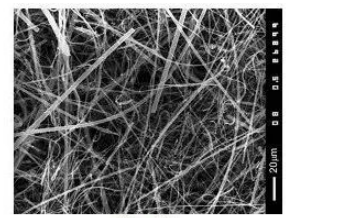The
AGM spacer used in
VRLA has the following additional functions:
-Absorb the electrolyte (the third active substance of the battery) so that it does not flow. Provide relatively large gas transmission holes for oxygen diffusion and consequently facilitate COC operation.
-Ensures high ionic conductivity. Provides transport channels for ionic flows to travel between the two types of polar plates, allowing redox reactions to proceed quickly.
-Limits PAM volume expansion and maintains pole group pressure, minimising the effects of pulsation of the positive active material during cycling
The figure illustrates a scanning electron micrograph (SEM) image of the AGM spacer sample.
As can be seen from the figure, the AGM spacer consists of chemical grade borosilicate glass fibres that are 1-2 mm in length and vary in thickness (0.1-10 μm in diameter). The ratio of the different fibres determines the balance between the different functions of the spacer and the price of the spacer. These fibres are hydrophilic and absorb the electrolyte. Finer fibres (i.e. fibres with smaller diameters) in the bulkhead have a larger surface area and form micropores with smaller internal diameters, but are more expensive.AGM bulkheads also contain 15-18% of polymer fibres such as PP, PE, etc., which increase the mechanical strength of the bulkheads and promote the formation of gas channels (as these materials are partially hydrophobic), which also reduces the price of the bulkheads.The production process of AGM bulkheads is similar to that of paper manufacturing. The process is similar to that of paper making, making it an anisotropic structure. The structure is characterised by a pore size of 2-4 μm in the x-y plane of the spacer, and micropores perpendicular to the x-y plane with a size of 10-30 μm [27]. The small pores in the x-y plane serve to distribute the electrolyte in the direction of the thickness of the spacer and to maintain its core-absorption rate when the spacer is partially filled with electrolyte. The large pores, on the other hand, form open gas channels.

14.2.4.2 Gas Transport through the AGM Separator
After being precipitated from the positive plate, oxygen is transported to the negative plate, where it then undergoes a reduction reaction. The whole oxygen transfer process passes through the following stages.
Firstly, oxygen forms tiny bubbles in the micropores of PAM filled with electrolyte. Then, these tiny bubbles gradually merge into discrete bubbles, which gradually replace the electrolyte in the micropores of the polar plate towards the bulkhead. A small portion of the oxygen in the bubbles reaching the surface of the polar plate is dissolved in the electrolyte, while most of the gaseous oxygen remains in the form of bubbles at the polar plate/spacer interface.The AGM spacer is a non-homogeneous structure, and therefore the oxygen accumulates in the parts of the AGM surface where the fibre density is low (loose structure) or in some of the vacancies between the polar plate and the spacer (tubular electrode/AGM).
Applying pressure on the polar cluster can bring the glass fibre surface into closer contact with the surface of the pole plate and promote oxygen penetration into the spacer. There are two possible reaction mechanisms:
1. When the pressure of the pole group is low, the volume of gas that accumulates at the pole plate/AGM spacer interface increases. The gas flow will rise vertically under the effect of gravity. The electrolyte density is twice as high as the gas density, pushing the gas upwards into the upper space of the polar cluster. In this way, oxygen will leave the pole group. The vertical flow rate of the gas depends on the current through the battery, the temperature of the electrolyte and the state of use of the battery (e.g. new battery or long term battery).
2. When the pressure in the pole group is high, the septum presses tightly against the pole plates and gas bubbles enter the septum. The gas bubbles move horizontally and try to increase the gas channels in the separator. The density of the glass fibre material structure is not uniform, and the bubbles enter the lower density parts of the fibres. The gas bubbles move not only randomly but also parallel along the surface of the spacer and in a direction perpendicular to the surface of the spacer. However, the gas flow moves mainly through the AGM bulkhead towards the negative plate where the gas pressure is lowest, and the pressure gradient pushes the oxygen in this direction. Under pressure, the gas replaces the electrolyte in the micropores of the spacer, and as a result, gas channels are formed. When continuous gas channels are formed, oxygen movement between the positive and negative plates is accelerated.
During the production of AGM separators for
VRLA batteries, the thickness of the separator is measured at a standard pressure of 10 kPa. In order to increase the contact between the plates and the spacer, the pole group (active body) is compressed, which reduces the thickness of the spacer by approximately 25%. The pole group of the high type stationary battery was tightened using a plastic bandage before being loaded into the battery slot, thus maintaining the pressure of the pole group.
In summary, AGM separators are given more functions that are critical to AGM batteries, no less than positive and negative plates. In addition to enabling oxygen transfer, it is more important to maintain a certain level of pressure in the pole group to ensure that the spacer is electrically conductive. This is further described in a subsequent tweet.

